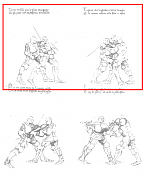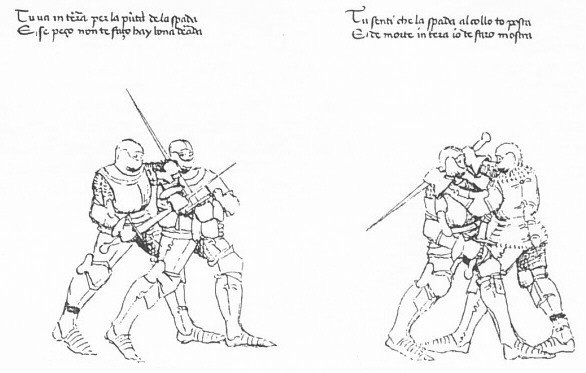 Interpretation/Notes: The verses written for both illustrations both emphasize the the "earth" implying that the opponent will no doubt end up on the ground vanquished or possibly "dead" as is indicated in the second verse. The term "neck" has different Italian words referring to it, such as pešo in the left verses and al collo which refers to a sling around the neck in the right verses. The tone of the text is more robust given that this is the first instance of the word death or morte in the verses. The confidence of the translations are relatively good in this case. Click on the image on the right to view a larger image of the plate.
Interpretation/Notes: The verses written for both illustrations both emphasize the the "earth" implying that the opponent will no doubt end up on the ground vanquished or possibly "dead" as is indicated in the second verse. The term "neck" has different Italian words referring to it, such as pešo in the left verses and al collo which refers to a sling around the neck in the right verses. The tone of the text is more robust given that this is the first instance of the word death or morte in the verses. The confidence of the translations are relatively good in this case. Click on the image on the right to view a larger image of the plate.
Practical Application: Liberi does not specify the particular posta one should begin with in preparation for the maneuvre described, however, it implies that the opponent's thrust may be parried with the posta di vera croce or guard of the cross which appears to work well in a practical sense. Upon the thrust, the defender while parrying aside the thrust with the posta di vera croce would take a passing step with the left leg to maneuvre behind the attacker and raise the point against the attacker's throat. This provides the leverage necessary to easily take the attacker down from behind.
In the second illustration, it appears that the master makes the first move, assuming the opponent has gripped his sword in a posta di vera croce stance, and rushes in to wrap the master's sword around the back of the neck for a take down. This maneuvre works very well and is one of the more popular maneuvres at AEMMA. It is also unclear if the pair of illustrations depict the movement from the left illustration to the right although it possible in practice providing one's footwork is well placed.

